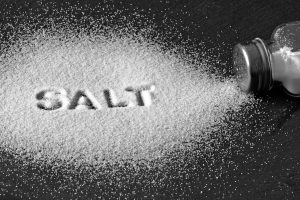
Image from Pixabay
With the rise of processed and convenience foods there has been a significant increase in salt intake – and we now know that our current consumption levels are actually excessive! And with very excess there is a price to pay! While sodium is essential for body functions like muscle contraction and fluid balance, a higher intake than required can lead to significant health risks. According to the World Health Organization (WHO), adults should consume less than 2,000 mg of sodium per day (which is about 5 grams of salt). Otherwise, there is a heightened risk of health complications like high blood pressure, heart disease, and stroke. Unfortunately, studies show that most people consume well above this safe amount, with the average intake in many countries double or even triple the recommended quantity! Canadians, on average, consume about 3,400 mg of sodium daily, which is well above the recommended daily intake of 2,300 mg for adults (and ideally 1,500 mg for optimal health), according to Health Canada. This intake is more than double the 1,500 mg target set by Canadian health guidelines.
The Risks of High Sodium Intake
1. Hypertension: One of the primary dangers of high sodium consumption is elevated blood pressure levels. Excessive sodium causes the body to retain water which increases the volume of blood and, consequently, blood pressure. Approximately one in four Canadian adults has high blood pressure, a primary risk factor for heart disease and stroke. Health Canada estimates that reducing sodium intake across the population could prevent around 23,000 cardiovascular events annually.
2. Increased Risk of Heart Disease and Stroke: High blood pressure puts strain on the cardiovascular system. A study published in the New England Journal of Medicine found that reducing sodium intake by just 1,000 mg per day could prevent an estimated 1.65 million deaths worldwide each year from heart disease.
3. Kidney Damage: The kidneys are responsible for filtering excess sodium from the bloodstream. When we consume too much sodium, the kidneys must work overtime, potentially leading to chronic kidney disease. A study conducted by the National Kidney Foundation found that diets high in sodium lead to a greater risk of kidney stones and renal issues.
4. Bone Health: Excess sodium intake can also negatively impact bones by increasing calcium loss in urine. When calcium is excreted at a higher rate, it may lead to decreased bone density and higher osteoporosis risk, especially in the elderly.
How to Reduce Sodium Without Compromising on Taste
Lowering sodium intake may seem challenging, especially when so many packaged foods are high in salt. Fortunately, there are several strategies to enjoy flavorful meals while keeping sodium in check.
1. Use Herbs and Spices: Instead of reaching for the salt shaker, try enhancing flavor with herbs and spices. Basil, oregano, garlic powder, onion powder, and paprika can add depth to dishes without the need for salt. Studies show that that individuals who used spices and herbs were able to reduce sodium intake by nearly 25% without noticing a decline in meal satisfaction.
2. Choose Fresh or Frozen Over Canned: Processed foods, especially canned goods, contain large amounts of sodium. Opting for fresh vegetables or unsalted frozen versions is preferable and if canned food is unavoidable then rinsing the contents thoroughly before cooking can reduce the sodium content.
3. Read Labels and Choose Low-Sodium: Foods labeled “low sodium” contain 140 mg of sodium or less per serving, making them a good option. Look for items specifically marked “no salt added” or “reduced sodium.”
4. Try Salt Alternatives: Potassium chloride-based salt substitutes can be a good choice for some, as they mimic saltiness without sodium. However, it is best to consult a doctor if you have kidney issues, as potassium levels must be monitored closely.
5. Add Acidic or Umami Flavors: Tangy or umami-rich ingredients like lemon juice, vinegar, and mushrooms can enhance the taste of food, giving it a savory profile that compensates for reduced salt. According to a study published in Journal of Sensory Studies, acidic flavors can stimulate the taste buds just like salt does, making them a natural substitute.
Conclusion
Reducing sodium intake is essential for long-term health, especially given the clear links between high sodium levels and serious health conditions. By making mindful choices and experimenting with alternative flavors, you can create delicious meals that do not rely on salt for taste. Remember, the journey to healthier eating does not have to be about giving up flavor – it is about finding smart, sustainable ways to enjoy what you eat while prioritizing your well-being.

Post Comments